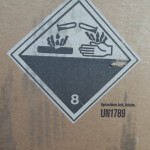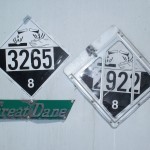Question to me (3.19.15) from a customer who had recently attended one of my TRAINING SEMINARS:
Dan,
I have a waste that is liquid but has no pH because it is not water-based. The SDS says it is DOT Class 8 so that means it must corrode steel at >0.25 inches/ year. RCRA has a similar criteria, but are DOT and RCRA referring to the same test standard? If yes, then I clearly have a hazardous waste. Let me know.
Thanks,
My reply, later that same day:
The EPA definition of the hazardous characteristic for corrosivity (40 CFR 216.22) is an aqueous solution with a pH of 2 or less or 12.5 or greater or…
(2) It is a liquid and corrodes steel (SAE 1020) at a rate greater than 6.35 mm (0.250 inch) per year at a test temperature of 55 °C (130 °F) as determined by Method 1110A in “Test Methods for Evaluating Solid Waste, Physical/Chemical Methods,” EPA Publication SW-846, and as incorporated by reference in §260.11 of this chapter.
 The DOT definition of Class 8 Corrosive includes a material that causes full thickness destruction of human skin at site of contact within a specified time period and…
The DOT definition of Class 8 Corrosive includes a material that causes full thickness destruction of human skin at site of contact within a specified time period and…A liquid, or a solid which may become liquid during transportation, that has a severe corrosion rate on steel or aluminum based on the criteria in §173.137(c)(2).
a corrosion on either steel or aluminum surfaces exceeding 6.25 mm (0.25 inch) a year at a test temperature of 55 °C (130 °F) when tested on both materials. The corrosion may be determined in accordance with the UN Manual of Tests and Criteria (IBR, see §171.7 of this subchapter) or other equivalent test methods.
Customers quick reply (still 3.19.15):
I’m curious, so on 3.20.15 I write:
Last correspondence on 3.20.15:
Conclusion:
The SDS says it is DOT Class 8 so that means it must corrode steel at >0.25 inches/ year.

Contact me with any questions you may have about the transportation of hazardous materials by air, highway, vessel, or rail International and Domestic Daniels Training Services 815.821.1550 |
